Did You Know That We Offer Contract to Closing Services? Click Here to Find Out More.
Need Marine Financing? Apply Here With Our Partner, First Approval Source
- Catamaran Interviews
- Catamaran Reviews
- Buying Advice
- Selling Advice
- Woods Design Advice
- Admiral 38
- Admiral 40
- Admiral 50
- Americat 3014
- Antares 44
- Aquila 44
- Aquila 48 Power Catamaran
- Aventura 37
- Balance 442
- Balance 482
- Balance 526
- Bali 4.0
- Bali 4.1
- Bali 4.2
- Bali 4.3
- Bali 4.4
- Bali 4.5
- Bali 4.6
- Bali 4.8
- Bali 40 Catspace
- Bali 5.4
- Bali Catsmart
- Beneteau Blue II
- Broadblue 346
- Broadblue 38 Prestige
- Broadblue 385
- Broadblue 435
- Broadblue 46
- Rapier 400
- Rapier 550
- Catalac 10M
- Catalac 11M
- Catalac 12M
- Catalac 8M
- Catalac 900
- Catalac 9M
- Catana 381
- Catana 39
- Catana 401
- Catana 40S
- Catana 411
- Catana 42
- Catana 42 S
- Catana 431
- Catana 44
- Catana 471
- Catana 50
- Catana 521
- Catana 531
- Catana 55
- Catana 581
- Catana 65
- Catathai 44
- Chris White
- Chris White 48 Voyager
- Chris White 55
- Condor 40
- Contour 34
- Corsair F28 R
- De Villiers
- Dean 365
- Dean 400
- Dean 440
- Dean 500
- Dix DH550
- Dolphin 380
- Dolphin 460
- Edel 35
- Endeavour 30
- Endeavour 35 Victory
- Endeavour 36
- Endeavour 44
- Endeavour 44 TrawlerCat
- Endeavour 50 Pilothouse Trawler
- Excess 11
- Excess 15
- F-41
- Fastback 43
- Fastcat 445
- Fisher 28
- Fisher 32
- Fortuna 36 Island Spirit
- Fortuna 401 Island Spirit
- Fountaine Pajot
- FP 32 Maldives
- FP 35 Tobago
- FP 36 Mahe
- FP 37 Antigua
- FP 38 Athena
- FP 39 Fidji
- FP 40 Isla
- FP 40 Lavezzi
- FP 40 Lucia
- FP 40 MY
- FP 40 Summerland MY
- FP 41 Lipari
- FP 42 Astrea
- FP 42 Venezia
- FP 43 Belize
- FP 44 Helia
- FP 44 Orana
- FP 45 Elba
- FP 46 Bahia
- FP 46 Casamance
- FP 48 Salina
- FP 50 Saba
- FP 56 Marquises
- FP 57 Sanya
- FP 58 Ipanema
- FP 60 Eleuthera
- FP Saona 47
- Fusion 40
- Gemini 105
- Gemini 3000
- Gemini 3200
- Gemini 3400
- Gemini Freestyle 37
- Gemini Freestyle 399 Power
- Gemini Legacy 35
- Grainger 420 Mystery Cove
- Gunboat 55
- Hirondelle 7M
- HopYacht 30
- Island Packet
- Island Packet Cat 35
- Kennex 420
- Knysna 440
- Knysna 480
- Knysna 500
- Knysna 550
- Lagoon 35
- Lagoon 37 TPI
- Lagoon 380
- Lagoon 39
- Lagoon 40
- Lagoon 400
- Lagoon 410
- Lagoon 42
- Lagoon 42 TPI
- Lagoon 420
- Lagoon 421
- Lagoon 43 PC
- Lagoon 44 Power Cat
- Lagoon 440
- Lagoon 450
- Lagoon 46
- Lagoon 470
- Lagoon 50
- Lagoon 500
- Lagoon 52F
- Lagoon 55
- Lagoon 560
- Lagoon 570
- Lagoon 620
- Lagoon Seventy 8
- Leeuwin 42
- Leopard 38
- Leopard 39
- Leopard 39 PowerCat
- Leopard 40
- Leopard 42
- Leopard 43
- Leopard 44
- Leopard 45
- Leopard 45 Classic
- Leopard 46
- Leopard 46 Lion PowerCat
- Leopard 47
- Leopard 47 PowerCat
- Leopard 48
- Leopard 50
- Leopard 51 PowerCat
- Leopard 53 PowerCat
- Leopard 58
- Lidgard 73 Executive
- Looping 50
- Maine Cat 30
- Maine Cat 38
- Maine Cat 41
- Manta 40
- Manta 42
- Matrix 450 Vision
- Matrix 760 Silhouette
- Maverick 400
- Maverick 420
- Maverick 440
- Moxie 61
- Nautitech 40
- Nautitech 40 Open
- Nautitech 44 Open
- Nautitech 442
- Nautitech 46 Open
- Nautitech 47
- Nautitech 47 Power
- Nautitech 475
- Nautitech 65
- Neel 45
- Neel 47
- Outremer 40
- Outremer 45
- Outremer 50 Standard
- Outremer 55
- Outremer 5X
- PDQ 32
- PDQ 36
- PDQ 42 Antares
- Privilege 37
- Privilege 39
- Privilege 42
- Privilege 43
- Privilege 435
- Privilege 45
- Privilege 465
- Privilege 48 Transcat
- Privilege 482
- Privilege 495
- Privilege 510
- Privilege 65
- Privilege Serie 5
- Prout 31 Quest
- Prout 33 Quest
- Prout 34 Event
- Prout 35 Snowgoose
- Prout 37 Snowgoose
- Prout 37 Snowgoose Elite
- Prout 38
- Prout 38 Manta
- Prout 39 Escale
- Prout 45
- Prout 46
- Royal Cape 45
- Royal Cape 500 Majestic
- Royal Cape 530 Majestic
- Sailcraft 30 Iroquois
- Sailcraft 32 Comanche
- Sailcraft 35 Cherokee
- Sailcraft 41 Apache
- Sailcraft 44 Apache
- Scape 39
- Wildcat 350
- Seacart 30
- Seawind 1000
- Seawind 1160
- Seawind 1200
- Seawind 1260
- Seawind 1600
- Simpson 48
- Solaris 36 Sunrise
- Solaris 36 Sunstar
- Solaris 42
- St Francis 44
- St Francis 48
- St Francis 50
- Stealth 11.8
- Sunreef 60
- Sunreef 62
- Sunreef 70
- Sunreef 74C
- Sunreef 82 DD
- Sunreef 88 DD
- Switch 51
- Switch 55
- TRT 1200
- Heavenly Twins 26
- Ocean Twins 38
- Vaan R5
- Vision 444
- Voyage 380 Maxim
- Voyage 400 Norseman
- Voyage 430 Norseman
- Voyage 440
- Voyage 450 Cabriolet
- Voyage 47 Mayotte
- Voyage 480
- Voyage 500
- Voyage 580
- Voyage 590
- Kronos 45
- Wharram 38 Tiki
- AMI 320 Renaissance
- Woods 22 Wizard
- Woods 35 Banshee
- Woods 35 Flica
- Woods 36 Scylla
- Woods 36 Vardo
- Woods 38 Transit
- Woods 40 Meander
- Xquisite X5
- Xquisite X5+

Catamaran Hull Design
- Post author By Rick
- Post date June 29, 2010
- 2 Comments on Catamaran Hull Design

Part 1: Notes from Richard Woods
Since the America’s Cup experimented with going multihull, there’s been a lot of interest in catamaran performance and the catamaran hull designs that define performance. Many guys are investigating whether to buy a catamaran or design and build their dream boat. Let it be said here that building a large catamaran is not for the faint of heart. People begin building 100s of boats a year, yet few are ever completed, as life always seems to have a way of interfering with a good boat build.
Never the less, since the rest of this website is about selecting and buying a boat , it only seems fair to have at least one webpage that covers catamaran design. This page contains notes on boat hull design goals and an accompanying page from Terho Halme has mathematical formulas used in actual catamaran hull design. It has become a popular research stop and an important reference to the catamaran design community.
The content of this page was reproduced from the maestro of Catamaran designs, renown British naval architect, Richard Woods, who not only designs catamarans, he sails them across oceans…. repeatedly. He has a lot to say on the subject of catamaran hull design.
“…When it’ all said and done, the performance of a sailing catamaran is dependent on three primary specs: length, sail area and weight. If the boat is longer it generally means it’ a faster boat. If she has more sail area, it means she’ a faster boat and if she’ light it means she’ a faster boat. Of course, there are limits: Too much sail area capsizes the boat in brisk winds. If the boat is designed too light, she will not take any kind of punishment. Too slim a hull design and the boat becomes a large Hobie Cat capable of only carrying your lunch. Of course, too long and large and you’d have to be Bill Gates to afford one. Then there are lot of additional and very important factors like underwater hull shape, aspect ratios of boards and sails, wet deck clearance, rotating or fixed rigging and so on….” Richard Woods
All Catamarans are not equal, but all sailboats have two things in common: They travel on water and they’re wind powered, so the Catamaran design equations in the 2nd part should apply to every catamaran from a heavy cruising Cat to a true ocean racer.
Richard Wood’s comments on catamaran design:
We all know that multihulls can be made faster by making them longer or lighter or by adding more sail. Those factors are the most important and why they are used as the basis of most rating rules. However using just those figures is a bit like determining a cars performance just by its hp and curbside weight. It would also imply that a Tornado would sail as fast forwards as backwards (OK, I know I just wrote that a Catalac went faster backwards than forwards)
So what next?? Weight and length can be combined into the Slenderness Ratio (SLR). But since most multihulls have similar Depth/WL beam ratios you can pretty much say the SLR equates to the LWL/BWL ratio. Typically this will be 8-10:1 for a slow cruising catamaran (or the main hull of most trimarans), 12-14:1 for a performance cruiser and 20:1 for an extreme racer.
So by and large faster boats have finer hulls. But the wetted surface area (WSA) increases proportionately as fineness increases (for a given displacement the half orange shape gives the least WSA) so fine hulls tend to be slower in low wind speeds.
The most important catamaran design hull shape factor, is the Prismatic Coefficient (Cp). This is a measure of the fullness of the ends of the hull. Instinctively you might think that fine ends would be faster as they would “cut through the water better”. But in fact you want a high Cp for high speeds. However everything is interrelated. If you have fine hulls you can use a lower Cp. Most monohulls have a Cp of 0.55- 0.57. And that is about right for displacement speeds.
However the key to Catamaran design is you need a higher Cp if you want to sail fast. So a multihull should be at least 0.61 and a heavy displacement multihull a bit higher still. It is difficult to get much over 0.67 without a very distorted hull shape or one with excessive WSA. So all multihulls should have a Cp between 0.61 and 0.65. None of this is very special or new. It has been well known by naval architects for at least 50 years.
There are various ways of achieving a high Cp. You could fit bulb bows (as Lock Crowther did). Note this bow is a bit different from those seen on ships (which work at very specific hull speeds – which are very low for their LOA). But one problem with them is that these tend to slam in a seaway.
Another way is to have a very wide planing aft section. But that can increase WSA and leads to other problems I’ll mention in a minute. Finally you can flatten out the hull rocker (the keel shape seen from the side) and add a bustle aft. That is the approach I use, in part because that adds displacement aft, just where it is most needed.
I agree that a high Cp increases drag at low speeds. But at speeds over hull speed drag decreases dramatically on a high Cp boat relative to one with a low Cp. With the correct Cp drag can be reduced by over 10%. In other words you will go 10% faster (and that is a lot!) in the same wind and with the same sails as a boat with a unfavorable Cp. In light winds it is easy to overcome the extra drag because you have lots of stability and so can fly extra light weather sails.
The time you really need a high Cp boat is when beating to windward in a big sea. Then you don’t have the stability and really want to get to your destination fast. At least I do, I don’t mind slowly drifting along in a calm. But I hate “windward bashing”
But when you sail to windward the boat pitches. The sea isn’t like a test tank or a computer program. And here I agree with Evan. Immersed transoms will slow you down (that is why I use a narrower transom than most designers).
I also agree with Evan (and why not, he knows more about Volvo 60 design than nearly anyone else on the planet) in that I don’t think you should compare a catamaran hull to a monohull, even a racing one. Why chose a Volvo 60/Vendee boat with an immersed transom? Why not chose a 60ft Americas Cup boat with a narrow out of the water transom??
To be honest I haven’t use Michelet so cannot really comment. But I have tested model catamarans in a big test tank and I know how inaccurate tank test results can be. I cannot believe that a computer program will be better.
It would be easy to prove one way or the other though. A catamaran hull is much like a frigate hull (similar SLR, L/B ratios and Froude numbers) and there is plenty of data available for those. There is also a lot of data for the round bilge narrow non planing motorboats popular in the 1930’-50’s which again are similar to a single multihull hull.
One of the key findings I discovered with my tank test work was just how great the drag was due to wave interference between the hulls. Even a catamaran with a modern wide hull spacing had a drag increase of up to 20 % when compared to hulls at infinite spacing. One reason why just flying a hull is fast (the Cp increases when you do as well, which also helps). So you cannot just double the drag of a single hull and expect to get accurate results. And any speed prediction formula must include a windage factor if it is to give meaningful results.About 25 years ago we sailed two identical 24ft Striders next to each other. They were the same speed. Then we moved the crew of one boat to the bow. That boat IMMEDIATELY went ½ knot faster. That is why I now arrange the deck layout of my racing boats so that the crew can stay in front of the mast at all times, even when tacking or using the spinnaker.
I once raced against a bridge deck cabin catamaran whose skipper kept the 5 crew on the forward netting beam the whole race. He won.
Richard Woods of Woods Designs www.sailingcatamarans.com
- Tags Buying Advice , Catamaran Designers

Owner of a Catalac 8M and Catamaransite webmaster.
2 replies on “Catamaran Hull Design”
I totally agree with what you say. But Uli only talk sailing catamarans.
If only solar power. You need the very best. As limited watts. Hp.
The closer to 1-20 the better.
Closing the hulls to fit in cheaper marina berth. ?
You say not too close. But is that for sailing only.
Any comment is greatly appreciated
Kind regards Jeppe
Superb article
Leave a Reply Cancel reply
Your email address will not be published. Required fields are marked *
Save my name, email, and website in this browser for the next time I comment.

- Find A School
- Certifications
- North U Sail Trim
- Inside Sailing with Peter Isler
- Docking Made Easy
- Study Quizzes
- Bite-sized Lessons
- Fun Quizzes
- Sailing Challenge

Small Boat Spotlight : The Everlasting Hobie 16
By: Pat Reynolds Learn To Sail , Sailboats , Sailing Fun
When you stop and think about what types of boats are most responsible for luring people into the wonderful world of sailing the Hobie 16 has got to be in the top three on the list. For children of the 1970s and 80s this sexy little catamaran seemed to be sitting on a trailer in every other backyard.
What most simply call the Hobie 16 is an iconic sailboat that is considered by many to be the most popular catamaran in the world. In the beginning, the H16 was marketed as more than some ordinary sailboat that could be easily trailered, rigged and beached. Instead Hobie Alter put forth the idea that to sail this boat was to be part of a lifestyle – the “ Hobie way of life .” Instead of making the pitch that it was a fast fun little boat that could make your summer a little brighter, Alter suggested that sailing a Hobiecat was a reflection of an energized youth with a dash of good-natured rebellion.
There have been over 135,000 of these boats produced since 1969 and they are the second largest boat fleet in existence. The H16 is simple to rig (especially on a beach) and pretty easy to sail, although capsizing is par for the course and regarded by some as fun. Once launched, the full batten main and relatively lightweight construction (320 pounds) makes the boat quite fast and responsive. The Hobie folks state the max speed is nearly 24-knots and there are plenty of Hobie sailors who will agree and verify. At speeds like that you can bet whoever is sailing the boat will be utilizing another element Hobie sailors love – the dual trapeze setup they are equipped with. In 10-15 knots of breeze, skipper and crew can hike their entire bodies out on the wires simultaneously, suspended above the water and as the hull begins to rise, life becomes very sweet. Any beach cat sailor will tell you that sailing along at 15-knots, hiked out and flying a hull is one of the most blissful feelings known to man.
The other very positive aspect of the Hobie 16 is the cost of entry. It remains one of the more inexpensive roads into the world of sailing. A 2017 Hobie 16 is just over $11,000 and that’s ready to sail. Lots of sailboats have a base price and then silly little extras like… sails!! And if the used market is explored, a ready to sail H16 can be picked up for under $1,000, which is pretty incredible.
And lastly, Hobie 16s are also versatile. They’re small enough to throw in the backyard next to the garage without causing marital dismay but once rigged and ready, they’re hearty enough to do some serious coastal sailing. While many Hobie sailors head out for a few hours for some low-key albeit amped up daysailing, others like to actually get in the surf, hit the adrenaline button and use the boat as a surfboard.
It’s a design that has definitely stood the test of time (for good reason) and one that is positive for the sport. The cost to fun ratio is right where we like to see it, so if you don’t have a boat and don’t want to spend a fortune – grab a Hobie 16 and getcha sail on!
Related Posts:

- Learn To Sail
- Mobile Apps
- Online Courses
- Upcoming Courses
- Sailor Resources
- ASA Log Book
- Bite Sized Lessons
- Knots Made Easy
- Catamaran Challenge
- Sailing Vacations
- Sailing Cruises
- Charter Resources
- International Proficiency Certificate
- Find A Charter
- All Articles
- Sailing Tips
- Sailing Terms
- Destinations
- Environmental
- Initiatives
- Instructor Resources
- Become An Instructor
- Become An ASA School
- Member / Instructor Login
- Affiliate Login
Sailing a catamaran
If the wind is strong enough to lift the windward hull, a catamaran will always sail on the apparent wind—meaning that speed forward through the water tightens the angle of the wind so that it always appears to be blowing from ahead, irrespective of the course sailed.
SAIL FREE AND FAST
The principal requirement of catamaran sailing is to build up apparent wind. When beating upwind, do not try to sail as close to the wind as possible, as with a conventional dinghy . Instead, bear off a few degrees to power up the rig's forward drive. Increased speed will more than compensate for lack of pointing.
Like any boat, a catamaran is at its fastest on a reach. On a run, with airflow over one side of the sails only, and both hulls down in the water, a catamaran is slow. To compensate, catamaran sailors
Sailing downwind on a three-sail reach, the mainsail is sheeted almost on the centerline due to the apparent wind angle and the speed of the catamaran. The helmsman keeps maximum control by holding the tiller bar and letting the tiller extension trail.
should "tack downwind." Start on a beam reach and head up toward the wind to build up power, lift the windward hull, and increase speed. The result is that the apparent wind direction moves ahead and the helmsman can bear away downwind, still sailing at speed and keeping the hull flying. If the speed decreases and the windward hull drops, he will head up toward the wind, then bear away again, with a succession of jibes taking the boat to a point dead downwind. A catamaran that "tacks" downwind will sail considerably farther than one sailing on a dead run, but owing to far greater speed will always reach a downwind point first.

SAILING A CATAMARAN 145
Catamaran no sail zone

POINTS OF SAILING
Catamaran sailors should beat to windward on a close reach, not attempting to point high upwind, which slows the boat and prevents the windward hull lifting. Running is also inefficient, except in light winds. Sail a succession of port and starboard broad reaches, jibing across the downwind course. Center the mainsheet for upwind sailing; ease it down the track downwind.
Continue reading here: Tacking and jibing a catamaran
Was this article helpful?
Recommended Programs

Myboatplans 518 Boat Plans
Related Posts
- Catamaran launching and landing
- Rigging a singlehanded dinghy
- Dropping the mainsail - Sailing Techniques
- Catamaran sailing downwind
- Introduction to catamarans
Readers' Questions
How close on a reach catamaran?
On a Reach catamaran, the distance between the two hulls is usually quite close. The width of the catamaran can vary depending on the specific model and size, but typically the hulls are placed closer together compared to other types of catamarans. This design allows for better stability and maneuverability, especially when sailing on a reach (a point of sail where the wind is coming from the side of the boat). The close proximity of the hulls also increases the overall deck space available on the catamaran.
Why don't a catamaran sail closer to the wind?
A catamaran is a type of boat with two parallel hulls, and it is known for its stability and speed. However, one limitation of catamarans is their ability to sail as close to the wind (into the wind) compared to other sailboats such as monohulls. There are a few reasons why catamarans cannot sail as close to the wind: High windage: Catamarans have a wider beam (the width of the boat) due to their double-hull design. This results in more surface area exposed to the wind, causing a higher windage. The wind pushing against the larger surface area makes it harder for the boat to point directly into the wind and maintain forward progress. Limited upwind performance: Catamarans are usually designed with larger and flatter hulls, which provide buoyancy and stability. However, these hull shapes create more drag and resist the boat's ability to sail upwind efficiently. They are not optimized for pointing directly into the wind. Lack of keel: Unlike monohull sailboats, catamarans do not have a deep keel extending below the waterline. Keels provide lateral resistance and prevent sideways slipping or skidding. This lack of keel reduces the ability of catamarans to sail upwind effectively. However, it's important to note that modern catamarans have made significant advancements in their upwind performance through design modifications and technological improvements. Newer models may have features like daggerboards or centerboards to enhance lift and lateral resistance, allowing them to sail closer to the wind compared to older designs.
How to sail a catamaran dinghy fast downwind?
Tune your rig: Make sure your sails are set correctly and the rigging is properly tensioned. Carefully trim the sails: Sheet in or out your mainsail and jib as needed to keep them filling in the wind as you make your course downwind. Center your weight: Sit in the middle of the cockpit and make sure your crew’s weight is evenly distributed. Keep the bow up: Heel the boat slightly to keep the bow from plunging into the waves. Maintain a smooth ride: Trim the sails to adjust the speed and angle of your course. Ride the waves: As you go downwind, find the best angle of attack by riding on the crest of the waves. Use the wind to your advantage: As the wind changes direction or intensity, adjust your sail trim accordingly to get the most speed.

Downwind Sailing on a Cruising Catamaran
Although sailing downwind in the trades in a cruising boat has its challenges, it is a relatively pleasant and fairly easy experience on a catamaran.
There is a more-or-less continuous flow of air across the Atlantic called the trade winds. Because the Earth is warmer at the equator and colder at the poles, and because of Earth’s rotation, this flow is generally westerly (from the west) near the poles and easterly nearer the equator.
Every season there is a migration of cruising boats that follow the trades when the trade winds are steady. One such migration is from the Mediterranean to the Caribbean across the Atlantic Ocean in November / December every year from east to west. It is the same downwind route that we took when we sailed our own boat back from France to the Caribbean in November 2019.
Although sailing downwind in the trades in a cruising boat has its challenges, it is a relatively pleasant and fairly easy experience on a catamaran. Assuming that your catamaran is a regular production cat like a Leopard, Bali or Lagoon, well equipped with cruising gear, you’ll perform much the same way as an equivalent monohull with either a conventional symmetrical spinnaker or asymmetric sail. Like on monohulls, you will pretty much sail to hull speed provided your catamaran is not overloaded. Performance cats are a different animal of course.

Therefor a regular cruising cat, much like a monohull, needs a lot of sail area and has to sail deep downwind if it is to achieve a decent speed made good (VMG), typically between 160° and 170°. But multihulls offer a unique wide platform for setting and sheeting downwind sails that set it apart from monohulls and make it a lot easier to sail downwind. The wide deck platform provides outboard sheeting points that makes downwind sails more efficient and the windward hull provides a tack location when sailing deeper angles is desired. Our preferred downwind sail is the assymmetrical spinnaker but a wing-on-wing configuration with dual head sails is very effective and, in many cases, safer and easier to handle for shorthanded crew.
Asymmetrical Sails for Downwind Sailing
Most modern catamarans choose to fly an asymmetric spinnaker and tack it to the weather bow. Sailmakers have managed to design these asymmetric sails so that they have more volume aloft. That means that even when you’re sailing deep angles, the luff of the sail sets well to windward and is able to catch more breeze that would have passed to windward of the boat. This configuration is pretty much as good as it gets for a cruising catamaran and is good for a range of apparent wind angles of between 90-160 degrees.
That was our sail plan onboard our Bali 5.4 when we did the Atlantic crossing…that is until we blew the asymmetrical sail halfway through our crossing and had to resort to using our Code Zero and jib in a wing-on-wing configuration for the duration of the trip. The spinnaker propelled us across the Atlantic fast. We easily did 200nm + days on the Bali 5.4 in 15 knots of wind.
The asymmetrical sail is a fantastic sail in light winds and once you understand just how easy it is to set and take down, it will be one of your favorite sails to use. These big downwind sails set forward of the mast and so, if there should be a sudden wind increase, the sheet can quickly be released, and the sail allowed to depower by streaming downwind. That means that when on passage, a cruising catamaran can always be rendered safe if things get a little out of hand. All being well, it can be snuffed, ideally while in the lee of the mainsail.
The key as always is in preparation. Make sure the sheets and halyard are all free to run and the sock is not crossed or tangled. The other mistake many of us tend to make is to over-sheet the spinnaker. One should let it fly out as far away from the boat as possible. It will make a huge difference. Keep easing the sheet until the luff curls, testing how far you can ease it out. You can always wind it back in. See the video here of how we set up our asymmetrical sail>>
We had our Asymmetrical sail made by Quantum in Annapolis, MD for our new Bali 5.4. It is a monster sail but surprisingly easy to handle. Andrew listened to our requirements for this downwind sail and built a sail that was ideally suited for our application. A word from our sailmaker at Quantum>> .
Wing-on-Wing Sail Configuration with Dual Headsails
The Code Zero is our favorite sail to use in light winds. It is the most popular cruising multihull downwind sail because they offer great versatility and cover a wide range of wind angles. Today the furling systems used with these sails are great and is as easy to use as a jib. We fly that sail most often and when the wind is just right on the beam, we really get flying. The Code Zero is best used with an AWS (apparent wind speed) of up to 18 knots, with an apparent wind angle (AWA) of less than 135 degrees.
When we blew out our asymmetrical sail halfway across the Atlantic, we were forced to use our head sails and our sailing became somewhat more conservative and a little slower. We set up a wing-on-wing configuration with the Code Zero to one side and the jib out to the other side of the boat. The two sails combine to create one giant sail, and the wind funnels from one sail to another and even though a touch slower than the asymmetrical, was totally adequate and is much more forgiving than sailing wing-on-wing with the headsail and mainsail where you have to use preventers etc. This configuration is also much more manageable and safer to handle for shorthanded crew or a couple.
Autopilot Wind Vane for Downwind Sailing on a Catamaran
When sailing with finicky sail configurations like the ones above, be sure to put your autopilot on wind vane mode and set the wind angle as a priority. That way, if the wind shifts, your autopilot will adjust the boat to have the sails properly filled. If you are running on a heading or a track when the wind shifts, you might find your sails backwinded or do an accidental gibe, which is dangerous.
Being on the wind vane setting does mean that you need to pay extra attention to your course; if the wind shifts, you may have to switch to another downwind sail tactic. Always get the boat balanced and steering comfortably before you switch on the autopilot. If the helm is overpowered and the steering is hard to control when you steer, the autopilot will have the same difficulty keeping a steady course. Set your right combination of sails and trim the sails well to set a comfortable course, then set the autopilot and watch it for a time to make sure it doesn’t labor too hard.
Chafe is Significant on Sails
Sailing downwind across the Atlantic, one will experience a lot of chafe on your running rigging. It’s a huge problem. We had our Code Zero come down while sailing from Madeira to the Canary Islands because the halyard was chafed right through in a few hours. Fortunately, we retrieved the sail without any issues, but it could have been a real problem. One should make provision for chafe and check your lines all the time. In fact, it is good practice to simply roam around the boat and check your running and standing rigging daily while on passage. We have bought several lengths of Dyneema sleeve and have sewn this chafe gear on the wear spots on the spinnaker halyard as well as all the reefing points on the main halyard.
Crash Stop or Quick Stop
Cruising yachts are mostly sailed by couples and are essentially short-handed. When a crew member goes overboard it is always at the worst possible time and completely unexpected, which means that the reaction time to start the correct maneuver is usually not good. The man overboard recovery method that we prefer being shorthanded, is called the “Crash Stop” or “Quick Stop”. It works in almost all situations and requires only one crew member and no sail trimming. Learn about the MOB Quick Stop Maneuver.
Parking Your Catamaran in Emergency
Parking the boat is an effective method for stopping anywhere and holding station, much like heaving-to in a monohull. Deep reef your main sail, drop the traveler all the way to leeward, and sheet the mainsheet hard in. Secure your helm so the rudders are pushing the boat into the wind. The cat will sit on a close-hauled course, drifting sideways at about ½ knot. This is great if you need a break from very harsh conditions or a squall. The motion will be smooth and will give you time to regroup or effect repairs if necessary.
FYI: If you own a Lagoon, Leopard or Fountain Pajot, you don’t necessarily have to have a sail built for your boat. There are pre-owned sails available to be purchased at a fraction of the cost.
Sail With Us to Learn

Week-Long Liveaboard Courses Rare RYA Classes & Certifications
Catamaran Guru’s real-life practical methods combined with up-to-date sailing theory in lessons aboard recent model catamarans…or your own boat!
Prepare for certifications or take the first step aboard to embark on your dream life of boat ownership or cruising
Classes in S Florida and the Bahamas.
Estelle Cockcroft
Join our community.
Get the latest on catamaran news, sailing events, buying and selling tips, community happenings, webinars & seminars, and much more!
Leave a Comment Cancel Reply
Your email address will not be published. Required fields are marked *
Save my name, email, and website in this browser for the next time I comment.
Recent Posts

Top 10 Reasons to Sell (and Sail) Your Catamaran in Texas
Our Texas Office is located in the Watergate Marina Center in Clear Lake Shores,
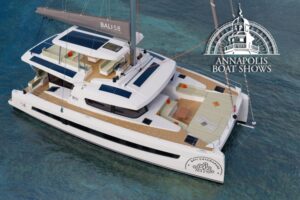
Annapolis Boat Show 2024
Meet with our team! Want to learn more about the Bali and Catana

Exploring the Catana OC 50 Catamaran: A Comprehensive Overview
The Catana OC 50 Catamaran, the latest addition to the Catana Ocean Class series,

Lessons Learned from Selling our Catana 50 OC
Stephen and I are in the process of selling our Catana OC 50 Catamaran.

For more than 30 years, we have been a part of the catamaran community and created Catamaran Guru™ to encourage and educate all the aspiring sailing out there. We understand the dream of traveling the world by catamaran and created a one-stop-shop to make that dream a reality for you.

- Stephen & Estelle
- Testimonials
Get Started
- Yacht Sales
- Used Yachts
- Charter Management
- Boat as Business Programs
- Seminars & Events
Visit our Popular Forums
- Monohull Sailboats
- Multihull Sailboats
- Powered Boats
- General Sailing
- Antares Yachts
- Fountaine Pajot
- Lagoon Catamarans
Cruising Business
- Boat Classifieds
- General Classifieds
- Crew Positions
- Commercial Posts
- Vendor Spotlight
Life Aboard a Boat
- Provisioning: Food & Drink
- Families, Kids, & Pets Afloat
- Recreation, Entertainment, & Fun
- Boat Ownership & Making a Living
- Liveaboard's Forum
Seamanship, Navigation & Boat Handling
- Seamanship & Boat Handling
- Training, Licensing, & Certification
- Health, Safety, & Related Gear
- Rules of the Road, Regulations, & Red Tape
Engineering & Systems
- Const. / Maint. / Refit
- Product / Service Reviews
- Electronics: Comms / AV
- Electrical: Batts / Gen / Solar
- Lithium Power Systems
- Engines & Propulsion
- Propellers & Drive Systems
- Plumbing / Fixtures
- Deck Hdw: Rigging / Sails
- Aux. Equipment & Dinghy
- Anchoring & Mooring
Photo Categories
- Member Galleries
- Life Onboard
- Sailing in the Wind
- Power Boats
- Cruising Destinations
- Maint. & Boat Building
- Marine Life
- Scuba Diving & Divers
- General Photos
Recent Photos

Listing Categories
- African Cats
- view more »
- Crew Wanted
- Crew Available
- Enhance Your Account
- Meet the Mods
- Meet the Advisors
- Signup for The Daily Cruiser Email

| ||||||||||||||||||||||||||||||||||||||||||||||||||||||||||||||||||||||||||||||||||||||||||||||||||||||||||||||||||||||||||||||||||||||||||||||||||||||||||||||||||||||||||||||||||||||||||||||||||||||||||||||||||||||||||||||||||||||||||||
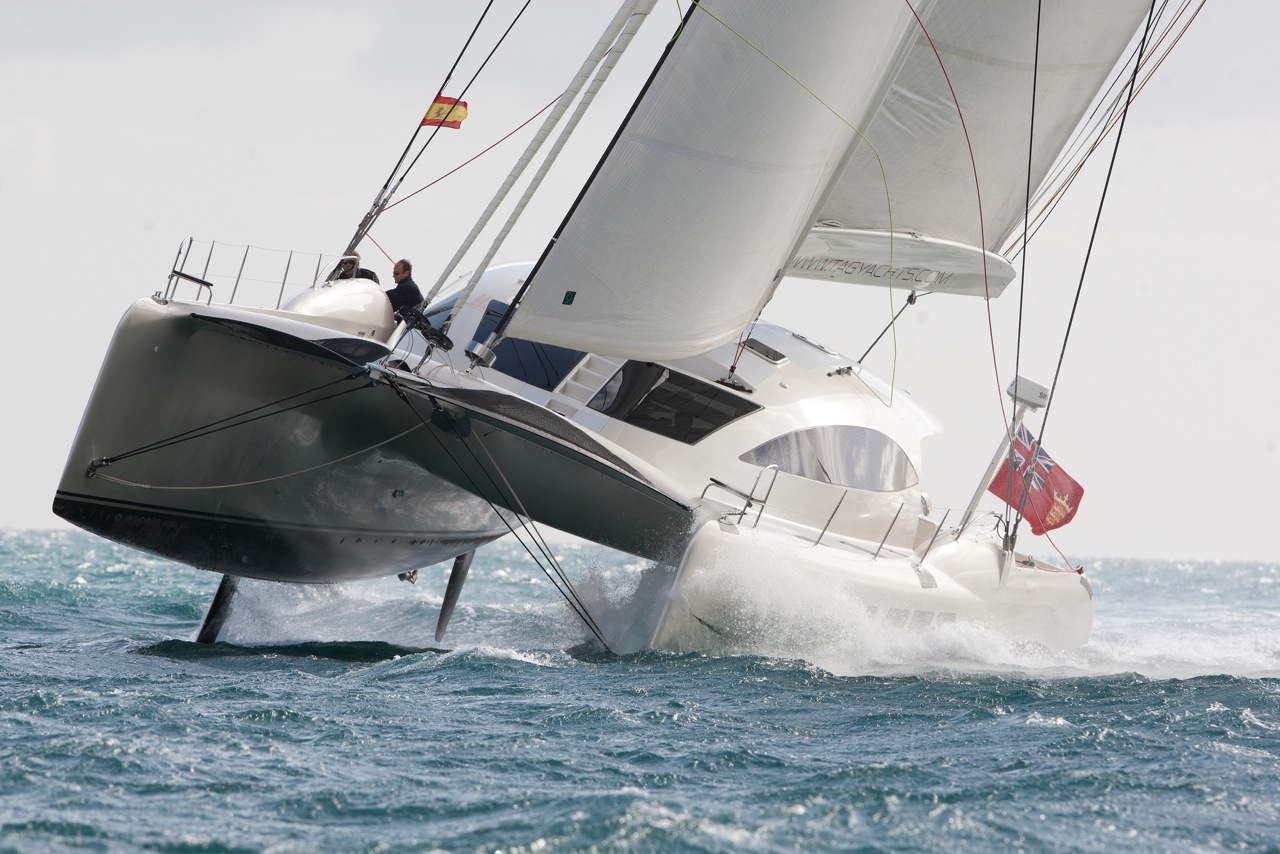
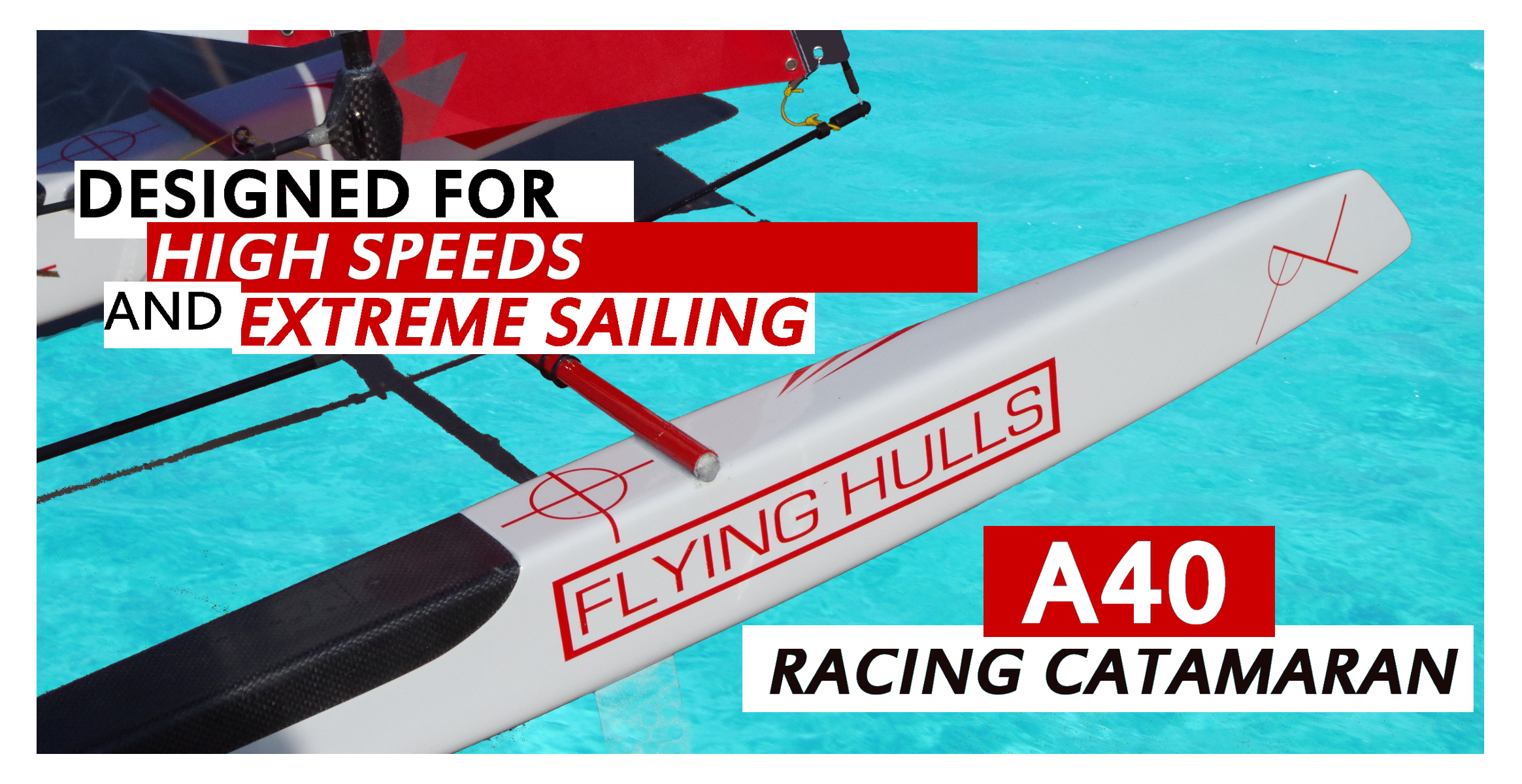

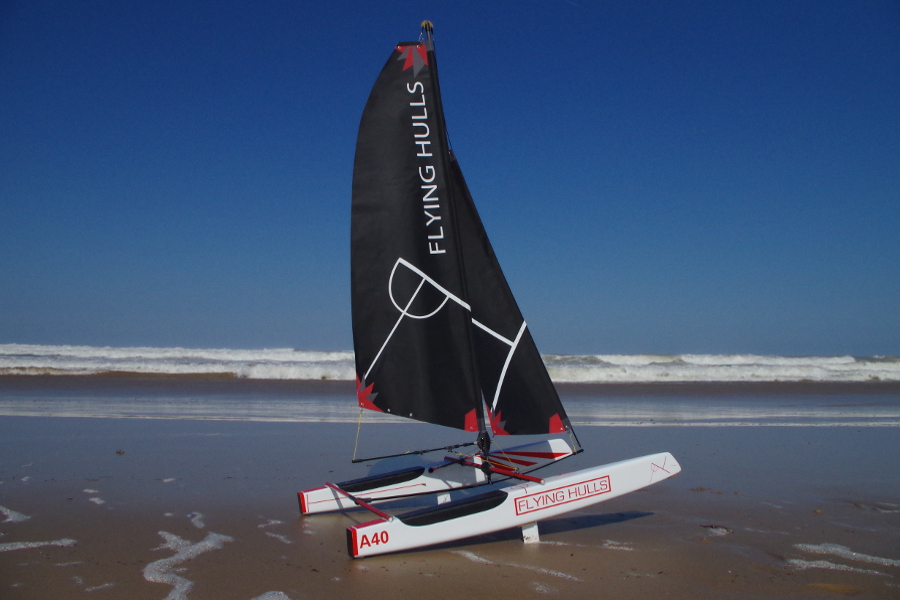



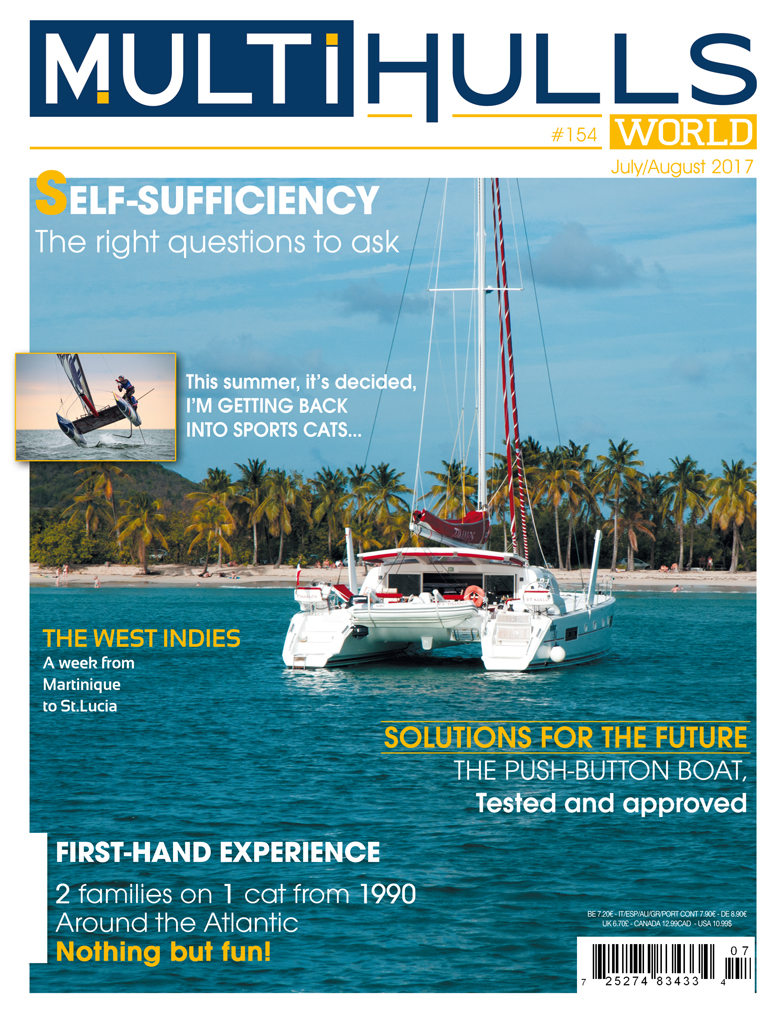
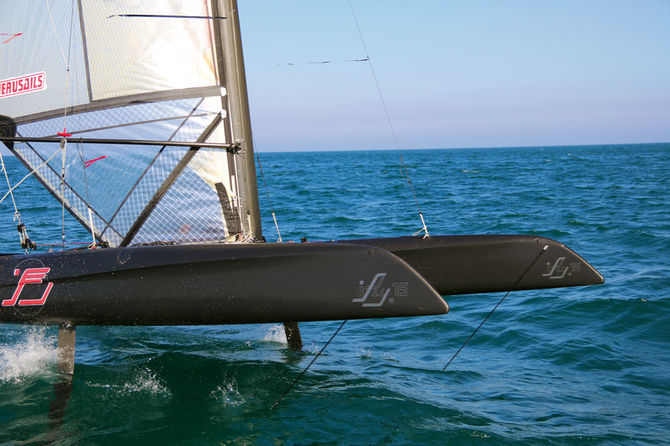
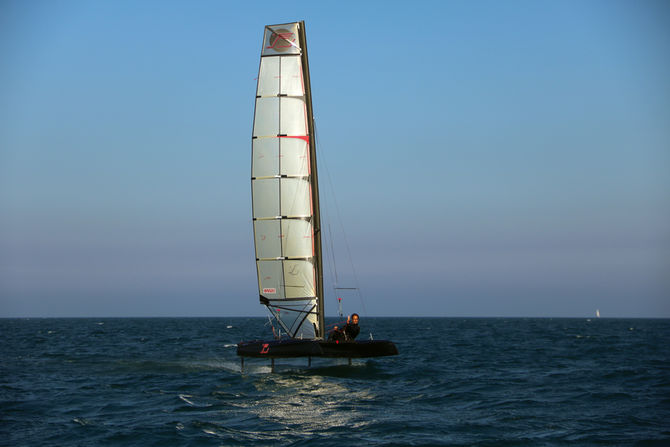
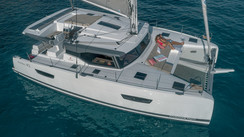



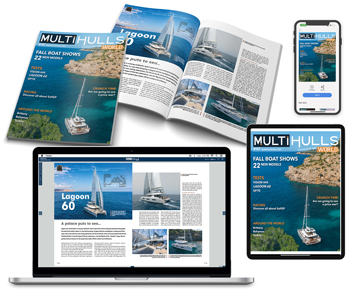
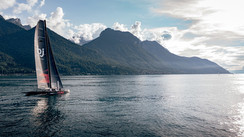
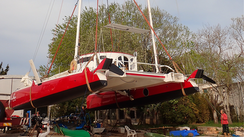
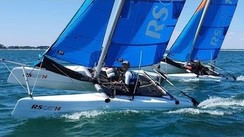
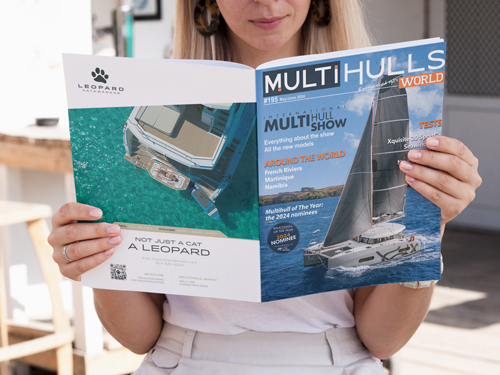






IMAGES
COMMENTS
Help Joe to get to the 2024 Tornado Worlds:https://gogetfunding.com/help-joe-compete-in-2024-tornado-championships/☞ SUPPORT JOYRIDER TV⛵️Channel Membership...
A catamaran doesn't heel over — it flies — which is certainly the feeling you get the first time the windward hull (which you're sitting on) lifts up out of the water. Flying a hull is the same thing as heeling on a monohull; it just looks cooler, because the windward hull is so high above the water. If you go too far, you invite a capsize (reducing your cool factor to zero).
HH Catamaran HH66-03 flying a hull at 20+ knots on day 5 of sea trials. An excited Bruce Livingston (VP) caught it on camera from the starboard transom.
Sebastian Lewis Flying a hull on a hobie 16
It makes it easier than sheeting in and out constantly. you need to get your sail trimmed and once you have some speed up you can fall off until you are on more of a reach and as you start to fly a hull higher you can point up to control your heel by steering up and down to the wind. Top. rafe.
Location: Tri-Cities, WA. Along with weight and wind speed, sail shape can make all the difference as to when your boat will fly a hull. If the sail is shaped right for the conditions (batten tension, down haul, out haul and main sheet tension) then you will fly at a lower wind speed than when not.
ANATOMY OF A CATAMARAN Look at the photographs on this page, and it will become clear why catamarans can sail so fast. Both crews are flying the windward hull, with just the leeward hull in the water. That super-slim hull has much less wetted surface area than any dinghy, which means there is far less drag. In addition, each of these catamarans has a beam of 8 ft (2.43 m), which is wider than ...
This page contains notes on boat hull design goals and an accompanying page from Terho Halme has mathematical formulas used in actual catamaran hull design. It has become a popular research stop and an important reference to the catamaran design community.
Any beach cat sailor will tell you that sailing along at 15-knots, hiked out and flying a hull is one of the most blissful feelings known to man. The other very positive aspect of the Hobie 16 is the cost of entry. It remains one of the more inexpensive roads into the world of sailing. A 2017 Hobie 16 is just over $11,000 and that's ready to ...
The result is that the apparent wind direction moves ahead and the helmsman can bear away downwind, still sailing at speed and keeping the hull flying. If the speed decreases and the windward hull drops, he will head up toward the wind, then bear away again, with a succession of jibes taking the boat to a point dead downwind.
That's when I thought of my Hobie Cat 16, Kat Baloo. When the wind was up she could sail anywhere as long as there was at least three inches of water to wet her stiletto-shaped hulls. In my youth I'd enjoyed sailing Kat Baloo fast, often flying a hull while hanging off her trapeze.
Catamaran sailing repair tips, pictures, forums and classified ads catamarans for sale by owner Hobie, Nacra, AHPC, Solcat, Aqua Cat for sale.
Flying a hull on a Hobie Wave catamaran pensacola joe 15 subscribers Subscribed 9 30K views 16 years ago Joe Hanneman sailing his Hobie Wave ...more
Fiberglass Hobie's fiberglass beach-launchable catamarans revolutionized sailing. Fly a hull and you'll understand the global obsession.
Experience the thrill of downwind sailing on a luxurious cruising catamaran. Sail effortlessly with the wind, embracing the ultimate adventure at sea.
Images: 69. Re: How often you see catamaran flying a hull? OTB cat's, open bridgedeck racing boats, you see them flying hulls pretty regularly. Never seen a bridgedeck cruising boat fly a hull. I've seen the occasional photo, a Gunboat or a Schionning G-Force - cruiser/racers, but never seen it in real life.
The A40 is a high-performance radio-controlled racing catamaran designed for high speeds and exciting sailing. It takes its design cues from all-out racing designs such as the Extreme40 and the C-Class catamarans.
The whirlwind evolution of catamaran design feels like the Wright brothers era. Orville and Wilbur made modifications to their flying machines almost daily and M&M isn't far from that. "Things change so quickly that by the time something is built and tested, we're already designing the next generation," says Morrelli.
A schionning 38ft catamaran travelling at 18 knots in 25-30knots of wind during the festival of sails in Geelong
The iFly 15 is capable of sailing on its foils from 10 knots of wind, and is surprisingly stable. Michael Miller has perfected a thick sail which is high-performance, reliable and easy to use. Sensors forward are supposed to simplify flying for novices…. Thanks to its beam limited to 2.55m (max for road transport), the iFly 15 can be ...
We can recommend the best iFLY setup and accessories for your boat. A great number of innovations all over the catamaran and the perfect match of all components allow controlled high-speed foiling experience. iFLY15 is full of innovations, e.g. in hull design, hydrofoils, rudders, automatic flight control system, two-layer wing trampoline, high ...
Hull flying session on my Hobie Bravo Catamaran. Wind 15-20.
Catamaran sailing repair tips, pictures, forums and classified ads catamarans for sale by owner Hobie, Nacra, AHPC, Solcat, Aqua Cat for sale.
The AC75, or America's Cup 75, is a 75ft foiling race boat with one carbon-fibre hull (a monohull instead of catamaran or trimaran) and has been described as like a "large windsurfing board with ...